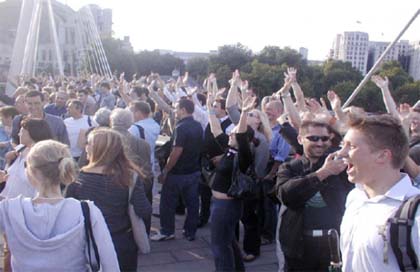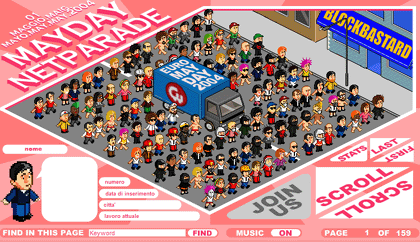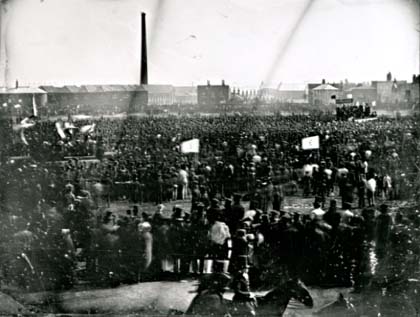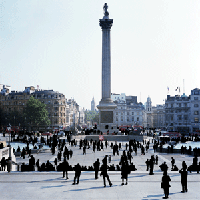The Crowd Compiled
What would a non-representational crowd look like? Anthony Iles examines some contemporary crowd phenomena and zooms in on two art projects which open up discussion of crowd politics in an era of criminalised and aestheticised protest
A look at the contemporary crowd from this writer's point of view (in London), would seem to immediately prompt the question: 'where did all the people go?'. The criminalization of protest initiated in Britain by the passing of the Criminal Justice Act seems to have reached its apogee and logical conclusion, after September 11th, in the policies of containment, suffocation and mediated division of particular actions into legitimate and illegitimate forms of protest. The apparent deadlock at Mayday 2003 and its subsequent cancellation this year in London (see www.ainfos.ca/en/ainfos13861.html), sums up the polarization that has developed between those who would make claim to a history of radical protest in the streets and their would-be paternal guardians - the police and the media. Yet, the other side of the same crisis, was embodied in the spectacle of the 'largest protest in British history' on February 15th, 2003. Two million people taking to the streets of London to demand that they be excused from the decision to go to war ('Not in My Name'); having apparently no effect on the process of political decision-making, opens up a vacuum that a new way of doing politics has so far failed to fill.
The project of the recomposition of the contemporary politicised crowd is not going to be easy, or quick. Here, I look at a few recent examples that clarify the classic assumption of the 'loss of subjectivity' within the crowd and propose the new forms of subjectification and sovereignty circulated and socialised in the contemporary crowd subject. I should begin by saying that few projects get over the tendency to view the crowd or mass in representational terms, but, that in this failure they indicate a limit that exposes its crucial point of departure.
1. Flash Mob
Adopting its name from a short story by science fiction writer Larry Niven, the flash mob is a crowd phenomenon inseparable from the socialisation of consumer telecommunications that inspired Niven's story and is used by this crowd to organize its manifestations. The flash mob apes the modes of organizing (through web sites, SMS and mailing lists) popularized by activist groups, but for no end other than consumptive display. As such this is a crowd that is part virtual, part conspicuous affect, which re-enacts and allegorises the demise of political agency for the contemporary crowd. The flash crowd typically satirises its own ability to do or undo its relation to cultural command by organizing anonymously, meeting in anonymity, making one simple absurdist gesture before dispersing once again.
 > Flash mob on Hungerford Bridge, London
> Flash mob on Hungerford Bridge, London
2. Netparade
As a virtual accompaniment to Mayday events in 2004 coordinated simultaneously in Milan and Barcelona, euromayday.org organized an online march in which contributors could submit their own avatars to the site to participate in a graphic visualization of the European multitude.
 > Mayday Netparade 2004: www.euromayday.org/netparade
> Mayday Netparade 2004: www.euromayday.org/netparade
In what must be the most orderly manifestation of the multitude ever seen, avatars march across the screen in columns, up and down the streets of Euroville demonstrating against 'flexibilisation' and for 'flexi-security'. Whilst the concept of singularities-together, seems to have been reduced to a choice of clip-art haircuts, t-shirts and the ability to input cheeky slogans, the site neatly sent-up the now largely deflated hyperbole around virtual crowds and made a space for participation and play that worked in synchronization with events on the ground. The virtual ideal of orderly lines of protesters could be seen as a nod towards a common knowledge that representational politics has no role to play in these struggles, yet, perhaps at this point, can hardly be avoided. The fact that many of the day's actions involved largely the occupation and blockading of 'private' spaces associated with consumption and precarious labour conditions - shopping malls, employment agencies and so on - is also worthy of reflection.
3. The Crowd Compiled
Crowd Compiler, a project by Christian Nold seeks to correct the common miscalculation of the size of crowds. Informed by both activism and political history, Nold proposes a simple imaging technology that would solve this age-old problem which is usually expressed in the vast discrepancy between police and protester estimates of the size of crowds. Interestingly this project compiles the crowd not only in space, but also in time, whereas traditionally historic photographs of crowds (see the famous image of the Chartists at Kennington below) assume a political rally has some sort of peak at which the assembled can be photographed and counted, much like in a school photograph.
 > Earliest ever photograph of a crowd: The Chartists at Kennington, 1848
> Earliest ever photograph of a crowd: The Chartists at Kennington, 1848
The Crowd Compiler works from an opposite principle assuming the most fundamental aspect of the crowd to be its fluidity; its ebbs and flows. Proposing a durational imaging of the crowd it hints at the screens of history, agency, contingency through which the crowd views itself but cannot be viewed. Importantly, it is not the number of people in a crowd but rather the mystification surrounding this issue that the project and accompanying text lays bare. Crowd Compiler makes a play between the traditional crowd which has sought representation within the official discourse of rights and democracy - such as the Chartists whose orderly assembly and attempts at officious paper protest was mocked and scorned by Parliament - and the contemporary crowd's evacuation of the tropes of this tradition[1].
 > Program views of Crowd Compiler, by Christian Nold
> Program views of Crowd Compiler, by Christian Nold
4. Revenants
'Some people believe that the crowd of the dead is the reservoir from which the souls of the newborn are taken.' [2]
 > Revenants by Eva Bensasson.....................................................The contemporary crowd lives on after its own death, that is in the evident bankruptcy of the public sphere in which it comes to participate. As Cannetti's remarks point out, the modern crowd is situated at the intersection between the crowd that has been: the sum of human animal lives past, and those to come. The contemporary crowd as captured in Revenants, a project by Eva Bensasson, exhibited recently at T1/2 Art space, London, refers us to the peculiar stasis of the subject - situated in spaces which could no longer be properly termed public but which stand in by default for the common (Trafalgar Square, Oxford Circus). As Paolo Virno has noted, the enclosure of the public sphere and previously existing commons by commodity capitalism means there is no longer any pre-capitalist common. 'Thus, there is nothing more shared and more common, and in a sense more public, than the feeling of 'not feeling at home' [3]. Inhabiting the only common available to them, Bensasson's crowds are first erased from space completely, then resituated as blank silhouettes, shadows of themselves as individuals, and finally entirely removed from the original places they occupied, to reappear as pure silhouettes in open luminous space. As such they constitute de-individualised, anonymous singularities, alienated not only from their surroundings, but also from each other and most of all from any political agency or potential for agitation which they may have held in the past or in times to come' Thus they are close to the figure Giorgio Agamben has theorised as the whatever being: 'The whatever singularity - this singularity that wants to take possession of belonging itself as well as of its own being-into-language, and thus declines any identity and any condition of belonging - is the new, nonsubjective, and socially inconsistent protagonist of the coming politics.' [4]
> Revenants by Eva Bensasson.....................................................The contemporary crowd lives on after its own death, that is in the evident bankruptcy of the public sphere in which it comes to participate. As Cannetti's remarks point out, the modern crowd is situated at the intersection between the crowd that has been: the sum of human animal lives past, and those to come. The contemporary crowd as captured in Revenants, a project by Eva Bensasson, exhibited recently at T1/2 Art space, London, refers us to the peculiar stasis of the subject - situated in spaces which could no longer be properly termed public but which stand in by default for the common (Trafalgar Square, Oxford Circus). As Paolo Virno has noted, the enclosure of the public sphere and previously existing commons by commodity capitalism means there is no longer any pre-capitalist common. 'Thus, there is nothing more shared and more common, and in a sense more public, than the feeling of 'not feeling at home' [3]. Inhabiting the only common available to them, Bensasson's crowds are first erased from space completely, then resituated as blank silhouettes, shadows of themselves as individuals, and finally entirely removed from the original places they occupied, to reappear as pure silhouettes in open luminous space. As such they constitute de-individualised, anonymous singularities, alienated not only from their surroundings, but also from each other and most of all from any political agency or potential for agitation which they may have held in the past or in times to come' Thus they are close to the figure Giorgio Agamben has theorised as the whatever being: 'The whatever singularity - this singularity that wants to take possession of belonging itself as well as of its own being-into-language, and thus declines any identity and any condition of belonging - is the new, nonsubjective, and socially inconsistent protagonist of the coming politics.' [4]
What links the examples I have mentioned here, and contemporary manifestations of the crowd more generally, then, is the crowd's tendency to evade representation and to reject subjectivity. The crowd's constituents act in a space circumscribed by the tradition of police surveillance and control, menaced on all sides by the implicit threat of the state of exception - their bodies exposed to the subjectivating measurement and capture of biopolitical forms of data tracking. These crowds are marked by commonality of 'not-feeling at home' and rejection of unitary identity. They make no articulate political demands, yet their very coming into being challenges and intimidates the state.
It is precisely in recognition of a 'public sphere' that has collapsed in on itself that these ghosts haunt its empty shell, improvising the forms of sociality left to them - language and communicability. Occupying a liminal space in the true suspension between the People - that forms the citizen body on which the discourse of rights is predicated - and the people - the excluded body the crowd has always been, they probe its limits looking for an opening.
Notes
[1] Christian Nold, Legible Mob, 2004, http://www.softhook.com/legible.htm[2] Elias Cannetti, Crowds and Power, Penguin, 1962. p77[3] Paolo Virno, The Grammar of the Multitude, Semiotext(e), 2004. p34[4] Giorgio Agamben, Means Without Ends, University of Minnesota Press, 2000. p88-89
Mute Books Orders
For Mute Books distribution contact Anagram Books
contact@anagrambooks.com
For online purchases visit anagrambooks.com






